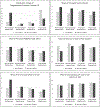The role of neighborhood economic context on physical activity among children: Evidence from the Geographic Research on Wellbeing (GROW) study
- PMID: 28601623
- PMCID: PMC10627422
- DOI: 10.1016/j.ypmed.2017.06.007
The role of neighborhood economic context on physical activity among children: Evidence from the Geographic Research on Wellbeing (GROW) study
Abstract
Less than half of young children in the U.S. meet physical activity recommendations. While neighborhood economic context has been shown to be associated with physical activity, it is unknown whether this association varies according to family economic context. This study thus investigates whether neighborhood economic context, measured by poverty concentration and income inequality, are associated with physical activity among poor and non-poor children using data from the Geographic Research on Wellbeing study, California, 2012-2013 (N=2670). Poor children who resided in (a) poor and equal neighborhoods or (b) non-poor and equal neighborhoods were more likely to engage in sufficient physical activity than were children residing in non-poor and unequal neighborhoods. Poor children in (a) non-poor and equal neighborhoods, (b) poor and equal neighborhoods, or (c) poor and unequal neighborhoods were less likely to report insufficient physical activity than those in non-poor and unequal neighborhoods. Neighborhood economic context was not associated with physical activity among non-poor children. Findings suggest that neighborhood economic context presents a social barrier to physical activity among poor children. Increasing physical activity among poor children in non-poor and unequal neighborhoods should be a high policy priority. Perceived social cohesion, perceived neighborhood safety, and park and walkability indicators did not mediate the associations between neighborhood economic context and physical activity. Further research needs to explore the mechanisms by which neighborhood economic context affects physical activity among children.
Keywords: Neighborhood economic context; Neighborhood income inequality; Neighborhood poverty; Physical activity.
Copyright © 2017 Elsevier Inc. All rights reserved.
Figures
Similar articles
-
Living in High-SES Neighborhoods Is Protective against Obesity among Higher-Income Children but Not Low-Income Children: Results from the Healthy Communities Study.J Urban Health. 2020 Apr;97(2):175-190. doi: 10.1007/s11524-020-00427-9. J Urban Health. 2020. PMID: 32107723 Free PMC article.
-
Neighborhood Poverty Histories and Physical Activity Among Children: Findings From the Geographic Research on Wellbeing (GROW) Study.Am J Health Promot. 2020 Nov;34(8):876-885. doi: 10.1177/0890117120923948. Epub 2020 May 11. Am J Health Promot. 2020. PMID: 32390465 Free PMC article.
-
Neighborhood Social Cohesion as a Mediator of Neighborhood Conditions on Mothers' Engagement in Physical Activity: Results From the Geographic Research on Wellbeing Study.Health Educ Behav. 2017 Dec;44(6):845-856. doi: 10.1177/1090198116687537. Epub 2017 Jan 31. Health Educ Behav. 2017. PMID: 28142286 Free PMC article.
-
The Price of Growing Up in a Low-Income Neighborhood: A Scoping Review of Associated Depressive Symptoms and Other Mood Disorders among Children and Adolescents.Int J Environ Res Public Health. 2023 Oct 5;20(19):6884. doi: 10.3390/ijerph20196884. Int J Environ Res Public Health. 2023. PMID: 37835154 Free PMC article.
-
A Scoping Review of Neighborhood Effects and Health Among Children and Adolescents: Measurement and Design Characteristics.J Community Psychol. 2025 May;53(4):e70013. doi: 10.1002/jcop.70013. J Community Psychol. 2025. PMID: 40347060 Free PMC article.
Cited by
-
The Longitudinal Effect of Area Socioeconomic Changes on Obesity: a Longitudinal Cohort Study in the USA from 2003 to 2017.J Urban Health. 2022 Dec;99(6):1068-1079. doi: 10.1007/s11524-022-00681-z. Epub 2022 Sep 19. J Urban Health. 2022. PMID: 36121565 Free PMC article.
-
Association of individual and neighbourhood socioeconomic status with physical activity and screen time in seventh-grade boys and girls in Berlin, Germany: a cross-sectional study.BMJ Open. 2017 Dec 28;7(12):e017974. doi: 10.1136/bmjopen-2017-017974. BMJ Open. 2017. PMID: 29288179 Free PMC article.
-
Neighborhood Economic Changes After the Great Recession and Home Food Environments.Health Educ Behav. 2019 Oct;46(5):737-748. doi: 10.1177/1090198119859409. Epub 2019 Jul 2. Health Educ Behav. 2019. PMID: 31266365 Free PMC article.
-
Living in High-SES Neighborhoods Is Protective against Obesity among Higher-Income Children but Not Low-Income Children: Results from the Healthy Communities Study.J Urban Health. 2020 Apr;97(2):175-190. doi: 10.1007/s11524-020-00427-9. J Urban Health. 2020. PMID: 32107723 Free PMC article.
-
Examining the Long-term Association Between Neighborhood Socioeconomic Status and Obesity and Obesity-related Unhealthy Behaviors Among Children: Results From the Fragile Families and Child Wellbeing Study.Ann Behav Med. 2023 Jul 19;57(8):640-648. doi: 10.1093/abm/kaad001. Ann Behav Med. 2023. PMID: 37000194 Free PMC article.
References
-
- Aber JL, Bennett NG, Conley DC, Li J, 1997. The effects of poverty on child health and development. Annu. Rev. Public Health 18 (1), 463–483. - PubMed
-
- Alvarado SE, 2011. The Effect of Neighborhood Context on Obesity and Educational Achievement Among Youth. University of Wisconsin – Madison.
-
- Babey SH, Tan D, Wolstein J, Diamant AL, 2015. Neighborhood, family and individual characteristics related to adolescent park-based physical activity. Prev. Med. 76, 31–36. - PubMed
-
- Baron RM, Kenny DA, 1986. The moderator–mediator variable distinction in social psychological research: conceptual, strategic, and statistical considerations. J. Pers. Soc. Psychol. 51 (6), 1173–1182. - PubMed
MeSH terms
Grants and funding
LinkOut - more resources
Full Text Sources
Other Literature Sources
Medical


